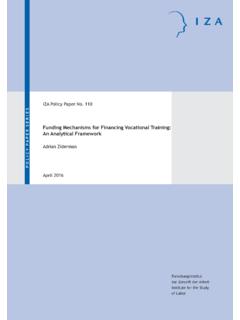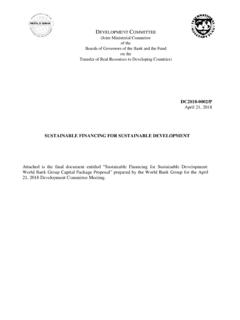Transcription of Financing Climate Futures - oecd.org
1 Synthesis and Key Messages for High-level Discussion New York, 25 September 2018 Financing ClimateFuturesRETHINKING INFRASTRUCTUREF inancing ClimateFuturesRETHINKING INFRASTRUCTURE1 The OECD, UN Environment and the World Bank Group have joined forces under a new initiative Financing Climate Futures : Rethinking Infrastructure. The initiative explores what public and private actors should do to trigger the radical transformation needed to align financial flows in infrastructure for a low-emission, resilient initiative, supported by the German Federal Ministry of the Environment, Nature Conservation and Nuclear Safety (BMU), stems from the 2017 G20 Hamburg Climate and Energy Action Plan, which called on the three organisations to compile ongoing public and private activities within the G20 for making financial flows consistent with the Paris goals and, building on this, to analyse potential opportunities for strengthening these efforts.
2 This synthesis report identifies six transformative areas that have the potential to help the different financial actors move beyond an incremental approach to the low-carbon transition towards the transformational agenda needed for decisive action. In addition to this synthesis, the Financing Climate Futures initiative consists of the following components: Shifting the Lens, a UN Environment analysis that explores the benefit of scenarios and foresight approaches in supporting the low-emission, resilient transition A series of case studies that dive deeper in specific aspects of these recommendations: Specific jurisdictions: Financing Climate objectives in cities and regions to deliver sustainable and inclusive growth (OECD); Financing Resilient Urban Infrastructure: Lessons from World Bank and Global Experience (World Bank Group); Greening the Belt and Road Initiative (UN Environment) Technologies: Blockchain, infrastructure and the low-emission transition (OECD); Decarbonising energy intensive industries: options and strategies (Imperial College).
3 How digital finance favours infrastructure investments, decarbonisation and energy access to all (UN Environment) Development finance: Mobilising commercial capital for sustainable infrastructure: Insights from national development banks in Brazil and South Africa (OECD); Achieving Clean Energy Access in Sub-Saharan Africa (Jan-Corfee Morlot & Carbon Limits Nigeria) The final report, which will be launched at COP24 in Poland in December 2018 Project BackgroundThis document, as well as any data and any map included herein, are without prejudice to the status of or sovereignty over any territory, to the delimitation of international frontiers and boundaries and to the name of any territory, city or area. Copyright: OECD/UN/World Bank Group 2018 We need to urgently deliver on our Climate and development goals, and to do so we need a systemic shift of trillions of dollars towards low-emission and resilient investment.
4 OECD countries should lead by example. Continuing along our current path is simply not an option. We must embrace the challenge of tackling Climate change and we must deliver on our Climate commitments. This report identifies six transformative areas to help us align financial flows with a low-emission, resilient future. Angel Gurr a, Secretary-General of the OECD We cannot ignore the new reality of powerful weather events that threaten jobs, homes, food security and other critical areas of our lives. The infrastructure that is built today must be ready to cope with tomorrow s changing Climate . We need the right incentives and regulations to urgently accelerate funding to these projects. Kristalina Georgieva, Chief Executive Officer of the World Bank Building Climate -compatible infrastructure is a cornerstone for the success of the Paris Agreement and broader sustainability goals, and we have seen encouraging momentum in this direction.
5 But we need to start making real change happen. Only sustainable infrastructure can deliver huge benefits to people and the planet. To encourage the capital allocation that will unlock this promise, however, we need new thinking. This report presents some of the steps we can take to make this change. Erik Solheim, Executive Director of UN EnvironmentFinancing ClimateFuturesRETHINKING INFRASTRUCTURE3 Financing Climate Futures : Rethinking InfrastructureCONTENTSE xecutive summary ..51. Getting infrastructure right for Climate and development ..72. Plan infrastructure for a low-emission and resilient future ..133. Unleash innovation to accelerate the transition ..194. Ensure fiscal sustainability for a low-emission, resilient future ..255. Reset the financial system in line with long-term Climate risks and opportunities ..316. Rethink development finance for Climate ..397.
6 Build low-emission and resilient urban societies ..45 Bibliography ..504 Six transformative areas to align financial flows with low-emission, resilient infrastructureRESETR eset the financial system in line with long-term Climate risks and opportunitiesRETHINKR ethink development finance for climatePLANEMPOWERPlan infrastructure for a low-emission and resilient futureBuild low-emission and resilient urban societiesINNOVATEU nleash innovation in technologies, institutions and business modelsBUDGETD isentangle public budgets from fossil fuel revenues5 Financing Climate Futures : Rethinking InfrastructureAligning financial flows with low-emission, resilient infrastructure has become an urgent need to attain Climate objectives and avoid further emissions lock-in. But infrastructure has suffered from chronic under-investment for decades. This investment gap and the urgency of the Climate challenge present a unique opportunity to enable sustainable growth and increase resilience worldwide.
7 Mobilising private resources across the financial spectrum will be necessary for sustainable investment in infrastructure, from public finance institutions to banks, institutional investors, corporations and capital markets. This mobilisation away from emission intensive projects will require getting the basic investment and Climate policies right, such as putting a price on carbon and reforming fossil fuel subsidies. Incentives that encourage rapid and radical transformation are also needed to drive systemic change, overcome institutional inertia, and break away from the vested interests that are often barriers to low-emission, resilient development. Harnessing rapid socio-economic and technological developments, such as digitalisation, will help to open new pathways to low-emission, resilient Futures . This means embracing systemic conceptual and behavioural changes in how we manage and govern our societies and economies.
8 The international community has increasingly recognised the need for such transformative action, not only through international agreements such as the Paris Agreement but also through forums such as the G7 and G20 (for example the G20 Hamburg Action Plan on Climate and Energy for Growth). But going beyond an incremental approach to Climate policy development and thinking outside the Climate box remains a challenge. This report lays out the agenda for a low-emission, resilient transformation that requires action across six key transformative areas, which should be articulated with respect to country contexts, and resource endowments and capacities: planning, budgeting, innovation, finance, development and cities. Plan sustainable and resilient infrastructure for a low-emission and resilient futureThere is a urgent need to rethink planning at all levels of governments to align current pipelines of infrastructure projects with long-term Climate objectives and avoid carbon lock-in.
9 Develop new institutional configurations to align infrastructure plans with a long-term low-emission, resilient development vision. Make resilience the norm in planning, and mainstream nature-based solutions and demand management tools in planning. Future-proof infrastructure investment decisions through approaches such as strategic foresight to monitor emerging socio-economic and technological changes and continuously adjust long-term strategies Unleash innovation to accelerate the transition to low-emissions technologies, business models and servicesAccelerating the deployment of existing technologies, business models and services, and swiftly moving the next generation of solutions from the lab to the market would open new opportunities for low-emission, resilient pathways. Deploy targeted innovation policies to create and shape markets for Climate innovations.
10 Scale-up public investment in Research and Development (R&D) of Climate solutions, and promote collaborative approaches to pool resources, lower R&D costs and technology risks. Overcome the financial barriers to demonstration, deployment and early-stage commercialisation through co-funding mechanisms, loan guarantees and new coalitions of financial actors. Promote international technology diffusion and R&D at Summary 6 Ensure fiscal sustainability for a low-emission, resilient future Carbon entanglement the dependence of governments on revenues from the production of fossil fuels - is a major political economy and macroeconomic constraint to a low-emission, resilient future transformation. Carbon entanglement can be overcome if long-term Climate policy planning also translates in budgetary policy. Diversify government revenues to reduce dependence on fossil fuels.















